
Named for the Pyrenees mountains separating France and Spain, the Great Pyrenees is a large and muscular breed of dog. Also known as the Pyrenean mountain dog, they originated in the mountains, where they have worked on farms for thousands of years. These stunning dogs have a rich and colorful history that has taken them to the home of royalty. So join us as we discover 10 incredible Great Pyrenees facts!
1. The Great Pyrenees Is An Old Breed

Great Pyrenees are an ancient dog breed.
©ejkrouse/ via Getty Images
We know that there are some pretty old dog breeds around, but the Great Pyrenees are so ancient that fossilized remains have been found! Found in France, these Bronze Age fossils date back to approximately 1,800 to 1,000 BC. It is thought that their ancestors were livestock guardian dogs brought to the Pyrenean mountains from Asia.
2. Great Pyrenees Dogs Were Used For Smuggling

The swashbuckling Great Pyrenees were once used by smugglers.
©Christy Hinko/ via Getty Images
Incredibly, Great Pyrenees dogs were even used by smugglers! Particularly during World War I, these dogs were used to carry packs containing contraband across dangerous and almost impassable routes in the Pyrenean mountains in order to avoid detection by customs officials. Their steady nature and sure-footed gait meant that they could travel along routes too narrow and dangerous for pack ponies.
3. The Great Pyrenees Was The Royal Dog Of France
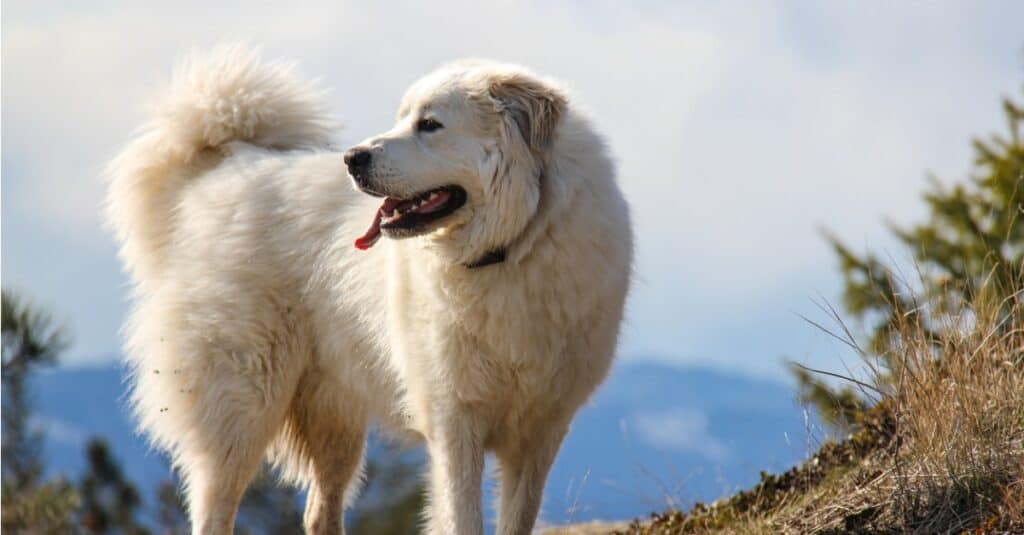
In 1675, the Great Pyrenees was made the Royal Dog of France.
©iStock.com/creativex
Although they initially started off as being farm dogs and often kept by peasant farmers, Great Pyrenees eventually made their way all the way to the Royal Court. In 1675, King Louis XIV named them as the Royal Dog of France. They were even popular with the British Royals as Queen Victoria owned one as well.
4. Great Pyrenees Dogs Guard Livestock
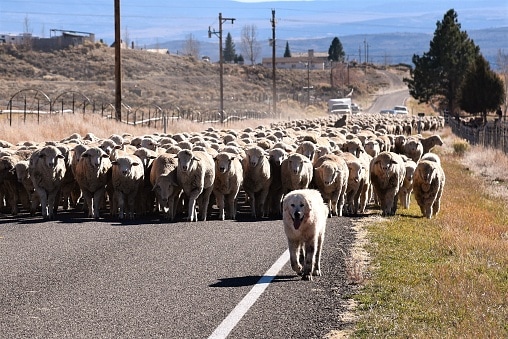
Great Pyrenees have guarded and herded livestock for thousands of years.
©Eric Clark/ via Getty Images
Even today, Great Pyrenees dogs still do the role that they have performed for thousands of years. This role is that of a livestock guardian. This involves protecting livestock such as sheep and goats from predators including wolves and bears. They typically form strong bonds with the animals that they are protecting as they spend all their time with them both guarding and protecting them. Great Pyrenees dogs are usually nocturnal by nature which only further enhances their prowess as a guardian. However, within a home environment, it can lead to them barking at any strange noise that they hear during the night.
5. Great Pyrenees Dogs Are Excellent Family Pets

The Great Pyrenees is one of the most gentle and affectionate breeds of dogs.
©iStock.com/JZHunt
Despite being known for their role in looking after livestock, Great Pyrenees actually make really good family pets. They are surprisingly gentle dogs for their size and have a patient and affectionate nature. They are also very tolerant around children which makes them a great all-around family pet. The great Pyrenees’ are extremely devoted to their owners. They can often be very protective of them, which means they can be wary of strangers.
6. The Great Pyrenees Takes Two Years To Mature
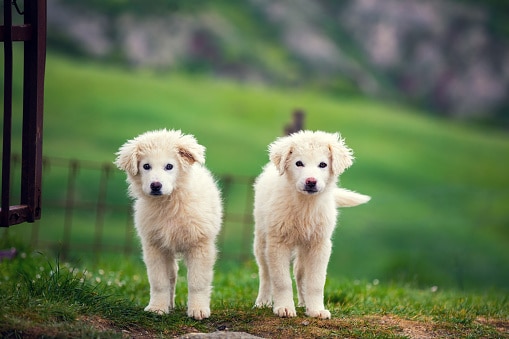
Large breeds like the Great Pyrenees take up to two years to fully mature.
©vvvita/ via Getty Images
As a large breed of dog, it takes the Great Pyrenees quite a while to fully mature. Although puppies are generally close to their adult size by the time they reach their first birthday, they still need the next 6 to 12 months to fill out properly. As adults, Great Pyrenees stand 25 to 32 inches tall at the shoulder and weigh 120 to 165 pounds.
7. The Great Pyrenees Helped To Save The Saint Bernard
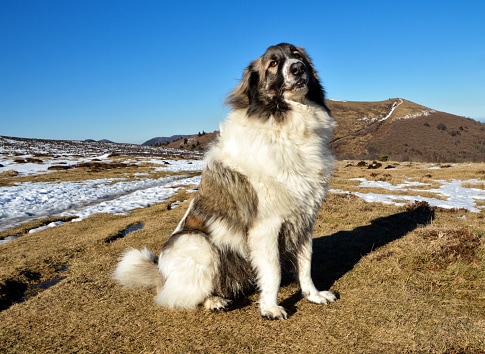
Saint Bernards were bred with the Great Pyrenees to help revive the breed.
©Jpr03/ via Getty Images
Saint Bernards are another large and loveable breed of dog, but they sadly almost died out in the 1800s. They are frequently used as rescue dogs, and the harsh winters of 1816 to 1818 caused vast numbers of them to lose their lives due to avalanches in the Swiss mountains while performing rescues. This left the breed on the verge of extinction. In fact, they would have died out were it not for the intervention of a few other breeds of dog. The remaining Saint Bernards were bred to several other large breeds of dog – including the Great Pyrenees – to help revive the breed. Luckily it worked, and today the Great Pyrenees is credited with helping to save the breed.
8. The Great Pyrenees Used To Deliver milk

As an all-around farm dog, Great Pyrenees even used to pull carts to deliver milk.
©Ingrid Curry/Shutterstock.com
As surprising as this might sound, the Great Pyrenees used to deliver milk in France and Belgium. They used to pull small carts and be used to go out on regular rounds making deliveries. They also pulled butcher carts and made similar rounds.
9. Great Pyrenees Dogs Have Extra Dewclaws

Certain breeds are known for having double dewclaws.
©Madeeva_11/Shutterstock.com
Dewclaws are the extra nails on the upper inner part of a dog’s foot. Most dogs have a single dewclaw on each front foot and no dew claws on their hind feet. A few breeds of dogs have single dewclaws in their hind feet, but Great Pyrenees go even further than that. This is because Great Pyrenees have not one but two dewclaws on their hind feet! These double dewclaws are thought to be to help the dog maintain stability while walking over rough mountain terrain. Considering that the breed originated in the mountains and that they live and work in them, it’s a pretty useful adaptation!
10. The Great Pyrenees Came Close to Extinction
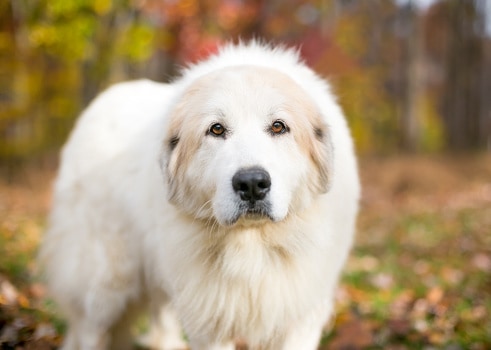
As the number of wolves dropped in mountain regions the need for dogs like the Great Pyrenees lessened.
©Mary Swift/ via Getty Images
For such a versatile breed with such an important job role, it might be a surprise to find that the Great Pyrenees almost died out – even more so considering their role in saving Saint Bernard. As the number of predators – particularly wolves – dropped in the mountains in the early 20th century, there became less need for them to guard flocks. As a result, fewer dogs were bred, and the number of pups born dropped drastically, leading the breed to the verge of extinction. Luckily, many of the born pups were sold to tourists, which is how the breed found its way into other countries. This led to them becoming better known and increased interest in them again.
Summary of 10 Incredible Great Pyrenees Facts
| Number | Facts |
|---|---|
| 1 | The Great Pyrenees Is An Old Breed |
| 2 | Great Pyrenees Dogs Were Used For Smuggling |
| 3 | The Great Pyrenees Was The Royal Dog Of France |
| 4 | Great Pyrenees Dogs Guard Livestock |
| 5 | Great Pyrenees Dogs Are Excellent Family Pets |
| 6 | The Great Pyrenees Takes Two Years To Mature |
| 7 | The Great Pyrenees Helped To Save The Saint Bernard |
| 8 | The Great Pyrenees Used To Deliver milk |
| 9 | Great Pyrenees Dogs Have Extra Dewclaws |
| 10 | The Great Pyrenees Came Close to Extinction |
The photo featured at the top of this post is © everydoghasastory/Shutterstock.com
Ready to discover the top 10 cutest dog breeds in the entire world?
How about the fastest dogs, the largest dogs and those that are -- quite frankly -- just the kindest dogs on the planet? Each day, AZ Animals sends out lists just like this to our thousands of email subscribers. And the best part? It's FREE. Join today by entering your email below.
Thank you for reading! Have some feedback for us? Contact the AZ Animals editorial team.






